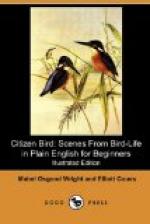The Doctor had set Rap, Nat, and Dodo roaming about to look for birds, and promised to tell them something of their habits when each child had written down the description of two birds.
The children divided their hunting ground, so that they might not interfere with each other. Dodo chose the woods, because she wanted to stay near Olive, who was making a sketch of some ferns; Rap took the old barn and a bit of bushy pasture near it, and Nat went down to the swampy meadow with its border of cedar trees. While they tramped about the Doctor sat with his back against the side of the barn, looking over the beautiful scene and thinking.
The children did not return until after Mammy Bun had spread out a delicious luncheon in the barn, and then they were divided between hunger and the wish to tell about their birds.
“I have two nice birds all written down,” said Dodo, between mouthfuls. “One was rather little and sort of green on top and white underneath, and he kept going up and down all the branches of an oak tree as if he couldn’t keep still a moment, and he talked all the while as if he was asking me why I watched him and then scolding me for doing it.”
“That is the Red-eyed Vireo,” said the Doctor.
“Maybe he did have red eyes,” said Dodo, “but he moved so quick I couldn’t see them. But my other bird was splendid! Very bright red all over, except his wings and tail—they were black, and I’m sure he has a nest high up on an oak branch.”
“That is the Scarlet Tanager. What did you see, Nat?”
“I crept in among the cedar trees, and there was a whole lot of rather big gray birds sitting in a row on a branch; they had black around their beaks and their head feathers stuck up in front. They didn’t seem to be building nests, but were only whispering to each other.”
“Those were Cedar Waxwings.”
“Then,” continued Nat, “when I was coming back I saw a flock of the prettiest, jolliest little birds flying round the old grass, and hanging on to some stalks of weeds. They were mostly yellow with some black, and they sang something like Canaries, and when they flew they sort of jerked along.”
“Those were American Goldfinches. And now for yours, Rap.” “I was looking at the Barn Swallows most of the time,” he answered, “and thinking there must be a good many different cousins in their family; then I went down to the pasture and saw a bird I never noticed before, who flew over from the potato field and went into a thorn bush. He was bigger than a Robin and had a thick head and beak. He was black and white on top, but when he went by I saw he had a beautiful spot on the breast like a shield—sort of pink red, the color of raspberries, you know.”
“That was the Rose-breasted Grosbeak,” said the Doctor. “Now, we have pockets full of material for bird stories,—enough to last a week. By the time you have heard about these six birds and some of their near relations, such as the Butcher Bird, you will have been introduced to the chief of the Birds that Sing and be on the way to those that only Croak and Call. We will begin with Dodo’s ‘Talking Bird.’”




